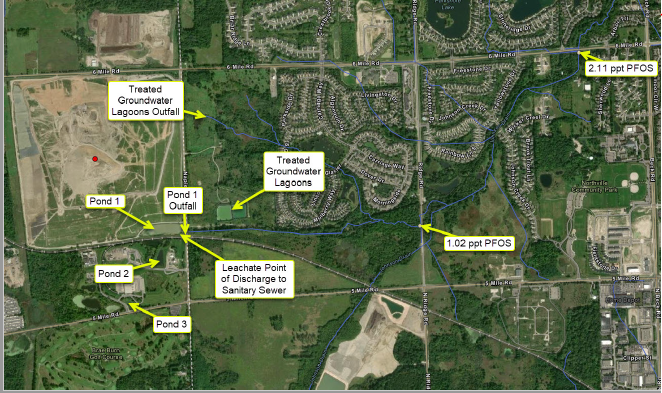Violation Issued to Arbor Hills for PFAS Discharge to Johnson Creek
<CLICK HERE> for a pdf version
Violation Notice Issued
On June 14, 2021, the Water Resource Division (WRD) of the Department of Environment, Great Lakes and Energy (EGLE) issued a violation (Violation Notice No VN-0011821) to Green for Life (GFL), the owner of the Arbor Hills Landfill in Salem, Michigan, for discharging PFOS[1] to Johnson Creek in concentrations above Michigan’s Water Quality Standards (WQS). The non-compliant discharge was first detected over a year ago (April 2020) but was not reported to EGLE until it was uncovered through a Freedom of Information Act Request by The Conservancy Initiative.
The discharge of any chemical in concentrations greater than established Water Quality Standards to the area’s only cold-water trout stream is of great concern, but the fact the discharge was not reported and apparently no response actions were taken, not even a follow-up sample, is even a greater concern. The non-compliant discharge occurred at the same time EGLE was pushing Arbor Hills to develop response plans for PFAS contamination identified in the very close vicinity to the non-compliant discharge. Failure to disclose the non-compliant discharge to Johnson Creek was perhaps either a willful decision or negligence that cannot be tolerated at a facility with so many inherent environmental and safety risks.
For more details of how the violation was detected see our previous post.
Violation Notice Details
The Conservancy Initiative was told to expect this violation when the non-compliant discharge was originally reported to EGLE over one month ago. This violation appears much more serious than most violations issued by the EGLE and that may explain the long lead time for the preparation.
The violation makes clear that fire suppression foam is likely not the only source of PFAS chemicals that need to be addressed at Arbor Hills.
GFL and Advanced Disposal have always pointed to the use of fire suppression foams used during a 2016 fire at the site’s recycling building as the source of PFAS contamination at the site.
It is highly unlikely the fire suppression foams which contaminate ponds 2 and 3 (see drawing below) could be responsible for PFAS contamination in pond 1, the stormwater detention pond. The stormwater detention pond is located across the railroad tracks and is believed to be at a higher elevation than ponds 2 and 3.
Leachate seepage and/or leakage on the landfill being washed down the landfill by stormwater may be a source of the PFAS.
The violation is ongoing since April 2020 and is continuing today.
GFL will be forced to accept an Administrative Consent Order (ACO) to address the problem.
The ACO will contain a process to comply with Water Quality Standards with a compliance plan and a schedule.
GFL has 30 days to respond agreeing to accept an ACO and submit a sampling plan to better characterize the extent of the issue.
Reference Maps
The attached maps identify most of the known locations of PFAS impacts at the Arbor Hills Landfill. The maps were prepared by EGLE and show how the landfill discharges stormwater and treated groundwater into very small tributaries of Johnson Creek which flow through many of the beautiful neighborhoods on the western portion of Northville Township. The Conservancy Initiative expects these maps will be updated as GFL investigates the sources of PFAS contamination.
Figure 1 - Locations with known PFAS Impacts at Arbor Hills Landfill (Prepared by EGLE)
Figure 2 - Locations with known PFAS Impacts near Arbor Hills Landfill. Results reported in Johnson Creek are from the Fall of 2020. (Prepared by EGLE)
[1] In this report, we use the acronyms PFAS and PFOS. PFAS refers to a large family of chemicals, Per- and polyfluoroalkyl substances which are man-made chemicals that includes PFOA, PFOS, GenX, and many other chemicals. PFOS refers to a specific chemical, Perfluorooctane sulfonate, which is a regulated in Michigan as a water contaminate.




